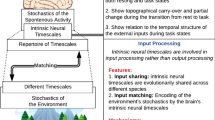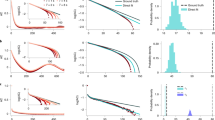Abstract
Human thought is highly flexible, achieved by evolving patterns of brain activity across groups of cells. Neuroscience aims to understand cognition in the brain by analysing these intricate patterns. We argue that this goal is impeded by the time format of our data—clock time. The brain is a system with its own dynamics and regime of time, with no intrinsic concern for the human-invented second. Here, we present the Brain Time Toolbox, a software library that retunes electrophysiology data in line with oscillations that orchestrate neural patterns of cognition. These oscillations continually slow down, speed up and undergo abrupt changes, introducing a disharmony between the brain’s internal regime and clock time. The toolbox overcomes this disharmony by warping the data to the dynamics of coordinating oscillations, setting oscillatory cycles as the data’s new time axis. This enables the study of neural patterns as they unfold in the brain, aiding neuroscientific enquiry into dynamic cognition. In support of this, we demonstrate that the toolbox can reveal results that are absent in a default clock time format.
This is a preview of subscription content, access via your institution
Access options
Access Nature and 54 other Nature Portfolio journals
Get Nature+, our best-value online-access subscription
$29.99 / 30 days
cancel any time
Subscribe to this journal
Receive 12 digital issues and online access to articles
$119.00 per year
only $9.92 per issue
Buy this article
- Purchase on Springer Link
- Instant access to full article PDF
Prices may be subject to local taxes which are calculated during checkout







Similar content being viewed by others
Data availability
We restructured and re-analysed the data of ref. 38 and simulated new data, which are available in the Brain Time Toolbox at https://github.com/sandervanbree/braintime. We re-analysed the data of ref. 39, which is available at https://osf.io/bpexa/.
Code availability
Code for the brain time analysis of the rodent and simulated data is included in the Brain Time Toolbox at https://github.com/sandervanbree/braintime. Custom code for analysis of the human data is available from the corresponding author upon request.
References
Antle, M. C. & Silver, R. Orchestrating time: arrangements of the brain circadian clock. Trends Neurosci. 28, 145–151 (2005).
MacDonald, C. J., Lepage, K. Q., Eden, U. T. & Eichenbaum, H. Hippocampal “time cells” bridge the gap in memory for discontiguous events. Neuron 71, 737–749 (2011).
Llinás, R. R. The intrinsic electrophysiological properties of mammalian neurons: insights into central nervous system function. Science 242, 1654–1664 (1988).
Buzsáki, G. & Draguhn, A. Neuronal oscillations in cortical networks. Science 304, 1926–1929 (2004).
Engel, A. K., Fries, P. & Singer, W. Dynamic predictions: oscillations and synchrony in top-down processing. Nat. Rev. Neurosci. 2, 704–716 (2001).
Jensen, O. & Mazaheri, A. Shaping functional architecture by oscillatory alpha activity: gating by inhibition. Front. Hum. Neurosci. 4, 186 (2010).
Klimesch, W. α-band oscillations, attention, and controlled access to stored information. Trends Cogn. Sci. 16, 606–617 (2012).
Capotosto, P., Babiloni, C., Romani, G. L. & Corbetta, M. Frontoparietal cortex controls spatial attention through modulation of anticipatory alpha rhythms. J. Neurosci. 29, 5863–5872 (2009).
Luo, H. & Poeppel, D. Cortical oscillations in auditory perception and speech: evidence for two temporal windows in human auditory cortex. Front. Psychol. https://www.frontiersin.org/article/10.3389/fpsyg.2012.00170 (2012).
Lakatos, P. et al. An oscillatory hierarchy controlling neuronal excitability and stimulus processing in the auditory cortex. J. Neurophysiol. 94, 1904–1911 (2005).
Busch, N. A., Dubois, J. & VanRullen, R. The phase of ongoing EEG oscillations predicts visual perception. J. Neurosci. 29, 7869–7876 (2009).
Romei, V., Gross, J. & Thut, G. On the role of prestimulus alpha rhythms over occipito-parietal areas in visual input regulation: correlation or causation? J. Neurosci. 30, 8692–8697 (2010).
Ai, L. & Ro, T. The phase of prestimulus alpha oscillations affects tactile perception. J. Neurophysiol. 111, 1300–1307 (2013).
Ruzzoli, M. & Soto-Faraco, S. Alpha stimulation of the human parietal cortex attunes tactile perception to external space. Curr. Biol. 24, 329–332 (2014).
Nowak, M., Zich, C. & Stagg, C. J. Motor cortical gamma oscillations: what have we learnt and where are we headed? Curr. Behav. Neurosci. Rep. 5, 136–142 (2018).
Joundi, R. A., Jenkinson, N., Brittain, J.-S., Aziz, T. Z. & Brown, P. Driving oscillatory activity in the human cortex enhances motor performance. Curr. Biol. 22, 403–407 (2012).
Hasselmo, M. E., Bodelón, C. & Wyble, B. P. A proposed function for hippocampal theta rhythm: separate phases of encoding and retrieval enhance reversal of prior learning. Neural Comput. 14, 793–817 (2002).
Hanslmayr, S., Axmacher, N. & Inman, C. S. Modulating human memory via entrainment of brain oscillations. Trends Neurosci. 42, 485–499 (2019).
Kerrén, C., Linde-Domingo, J., Hanslmayr, S. & Wimber, M. An optimal oscillatory phase for pattern reactivation during memory retrieval. Curr. Biol. 28, 3383–3392 (2018).
Jacobs, J., Hwang, G., Curran, T. & Kahana, M. J. EEG oscillations and recognition memory: theta correlates of memory retrieval and decision making. NeuroImage 32, 978–987 (2006).
Polanía, R., Moisa, M., Opitz, A., Grueschow, M. & Ruff, C. C. The precision of value-based choices depends causally on fronto-parietal phase coupling. Nat. Commun. 6, 8090 (2015).
Mazaheri, A. & Jensen, O. Posterior α activity is not phase-reset by visual stimuli. Proc. Natl Acad. Sci. USA 103, 2948–2952 (2006).
Jansen, B. H., Agarwal, G., Hegde, A. & Boutros, N. N. Phase synchronization of the ongoing EEG and auditory EP generation. Clin. Neurophysiol. 114, 79–85 (2003).
Cole, S. R. & Voytek, B. Brain oscillations and the importance of waveform shape. Trends Cogn. Sci. 21, 137–149 (2017).
Sauseng, P. et al. A shift of visual spatial attention is selectively associated with human EEG alpha activity. Eur. J. Neurosci. 22, 2917–2926 (2005).
Buzsáki, G. The Brain from Inside Out (Oxford Univ. Press, 2019).
Scharnowski, F., Rees, G. & Walsh, V. Time and the brain: neurorelativity: the chronoarchitecture of the brain from the neuronal rather than the observer’s perspective. Trends Cogn. Sci. 17, 51–52 (2013).
Klimesch, W. EEG alpha and theta oscillations reflect cognitive and memory performance: a review and analysis. Brain Res. Rev. 29, 169–195 (1999).
Kösem, A., Gramfort, A. & van Wassenhove, V. Encoding of event timing in the phase of neural oscillations. NeuroImage 92, 274–284 (2014).
Ter Wal, M. et al. Theta rhythmicity governs human behavior and hippocampal signals during memory-dependent tasks. Nat. Commun. 12, 7048 (2021).
Bonnefond, M. & Jensen, O. Gamma activity coupled to alpha phase as a mechanism for top-down controlled gating. PLoS ONE 10, e0128667 (2015).
Qasim, S. E., Fried, I. & Jacobs, J. Phase precession in the human hippocampus and entorhinal cortex. Cell 184, 3242–3255 (2021).
Williams, A. H. et al. Discovering precise temporal patterns in large-scale neural recordings through robust and interpretable time warping. Neuron 105, 246–259 (2020).
Sakoe, H. & Chiba, S. Dynamic programming algorithm optimization for spoken word recognition. IEEE Trans. Acoust. Speech Signal Process. 26, 43–49 (1978).
Berndt, D. J. & Clifford, J. Using dynamic time warping to find patterns in time series. In Proc. 3rd International Conference on Knowledge Discovery and Data Mining, 359–370 (AAAI, 1994).
Thut, G., Nietzel, A., Brandt, S. A. & Pascual-Leone, A. Alpha-band electroencephalographic activity over occipital cortex indexes visuospatial attention bias and predicts visual target detection. J. Neurosci. 26, 9494–9502 (2006).
Worden, M. S., Foxe, J. J., Wang, N. & Simpson, G. V. Anticipatory biasing of visuospatial attention indexed by retinotopically specific alpha-band electroencephalography increases over occipital cortex. J. Neurosci. 20, RC63 (2000).
Newman, E. L. & Hasselmo, M. E. (2014). Grid cell firing properties vary as a function of theta phase locking preferences in the rat medial entorhinal cortex. Front. Syst. Neurosci. https://www.frontiersin.org/article/10.3389/fnsys.2014.00193 (2014).
Bae, G.-Y. & Luck, S. J. Decoding motion direction using the topography of sustained ERPs and alpha oscillations. NeuroImage 184, 242–255 (2019).
Bouwer, F. L., Honing, H. & Slagter, H. A. Beat-based and memory-based temporal expectations in rhythm: similar perceptual effects, different underlying mechanisms. J. Cogn. Neurosci. 32, 1221–1241 (2020).
King, J.-R. & Dehaene, S. Characterizing the dynamics of mental representations: the temporal generalization method. Trends Cogn. Sci. 18, 203–210 (2014).
Hafting, T., Fyhn, M., Molden, S., Moser, M.-B. & Moser, E. I. Microstructure of a spatial map in the entorhinal cortex. Nature 436, 801–806 (2005).
Grootswagers, T., Wardle, S. G. & Carlson, T. A. Decoding dynamic brain patterns from evoked responses: a tutorial on multivariate pattern analysis applied to time series neuroimaging data. J. Cogn. Neurosci. 29, 677–697 (2017).
Jacobs, J. et al. Direct recordings of grid-like neuronal activity in human spatial navigation. Nat. Neurosci. 16, 1188–1190 (2013).
Burgess, N. & O’Keefe, J. Models of place and grid cell firing and theta rhythmicity. Curr. Opin. Neurobiol. 21, 734–744 (2011).
Kriegeskorte, N., Simmons, W. K., Bellgowan, P. S. F. & Baker, C. I. Circular analysis in systems neuroscience: the dangers of double dipping. Nat. Neurosci. 12, 535–540 (2009).
Pletzer, B., Kerschbaum, H. & Klimesch, W. When frequencies never synchronize: the golden mean and the resting EEG. Brain Res. 1335, 91–102 (2010).
Hughes, S. W. et al. Synchronized oscillations at α and θ frequencies in the lateral geniculate nucleus. Neuron 42, 253–268 (2004).
Vijayan, S. & Kopell, N. J. Thalamic model of awake alpha oscillations and implications for stimulus processing. Proc. Natl Acad. Sci. USA 109, 18553–18558 (2012).
Koepsell, K. et al. Retinal oscillations carry visual information to cortex. Front. Syst. Neurosci. https://doi.org/10.3389/neuro.06.004.2009 (2009).
VanRullen, R. Perceptual cycles. Trends Cogn. Sci. 20, 723–735 (2016).
ten Oever, S., De Weerd, P. & Sack, A. T. Phase-dependent amplification of working memory content and performance. Nat. Commun. 11, 1832 (2020).
van Wassenhove, V. Temporal cognition and neural oscillations. Curr. Opin. Behav. Sci. 8, 124–130 (2016).
Kostov, V. B. et al. Kepler-413b: a slightly misaligned, Neptune-size transiting circumbinary planet. Astrophys. J. 784, 14 (2014).
Donoghue, T. et al. Parameterizing neural power spectra into periodic and aperiodic components. Nat. Neurosci. 23, 1655–1665 (2020).
Benjamini, Y. & Yekutieli, D. The control of the false discovery rate in multiple testing under dependency. Ann. Stat. 29, 1165–1188 (2001).
Acknowledgements
We thank E. Newman, F. Meconi, G.-Y. Bae and S. J. Luck for sharing their data and B. Griffiths for his insightful comments on the Brain Time Toolbox. This research was funded by the European Research Council (grant no. 715714 for M.W. and 647954 for S.H.), the Economic and Social Research Council (ES/R010072/2 for S.H.) and the Autónoma University of Madrid (FPI-UAM 2017 for M.M.). The funders had no role in study design, data collection and analysis, decision to publish or preparation of the manuscript.
Author information
Authors and Affiliations
Contributions
The Brain Time Toolbox was conceived and developed by S.B., M.M. and S.H. with consultation from L.K., C.K. and M.W. The simulated dataset was generated and analysed by S.B., M.M. and S.H. The remaining datasets were analysed by S.B. and S.H. The manuscript was written by S.B. and S.H. with input from M.M, L.K., C.K. and M.W.
Corresponding author
Ethics declarations
Competing interests
The authors declare no competing interests.
Peer review
Peer review information
Nature Human Behaviour thanks Anne Urai and the other, anonymous, reviewer(s) for their contribution to the peer review of this work. Peer reviewer reports are available.
Additional information
Publisher’s note Springer Nature remains neutral with regard to jurisdictional claims in published maps and institutional affiliations.
Supplementary information
Supplementary Information
Supplementary Sections 1–3 and references.
Rights and permissions
About this article
Cite this article
van Bree, S., Melcón, M., Kolibius, L.D. et al. The brain time toolbox, a software library to retune electrophysiology data to brain dynamics. Nat Hum Behav 6, 1430–1439 (2022). https://doi.org/10.1038/s41562-022-01386-8
Received:
Accepted:
Published:
Issue Date:
DOI: https://doi.org/10.1038/s41562-022-01386-8
This article is cited by
-
Rhythmicity of neuronal oscillations delineates their cortical and spectral architecture
Communications Biology (2024)



